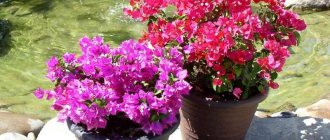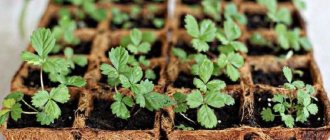Cuttings have long been considered the only and most effective way to propagate ornamental roses. Today, more and more gardeners prefer to experiment and prefer planting seeds. This is a long and labor-intensive process, but as a result the plant has increased resistance, immunity and an attractive appearance.
If you follow planting technology and proper care, you can grow a rose from seeds even at home. From the article you will learn all the intricacies of this method of reproduction.
Benefits of growing roses from seeds
Growing roses from seeds is a complex process that takes a lot of time and effort. It is possible to achieve flowering of the plant only after several years from the moment of planting. Despite this, this method has undeniable advantages:
- unlike cuttings, you can get several plants, which is especially important when landscaping the area, creating a flower bed or hedge on the site;
- roses grown from seeds are more resistant to disease and are stronger and more resilient plants;
- using seed propagation you can get a potted rose that can be grown indoors;
- the cost of seeds is significantly lower than rose cuttings, which makes it possible to save money when planting a large volume.
Planting material is difficult to find on sale, so flower growers often order seeds from China. However, the so-called Gift roses ordered from China do not always germinate, and the result of growing can be completely unpredictable.
You can also get the seeds yourself by collecting them after the adult plant has flowered, but they have low germination capacity and quickly deteriorate.
Advantages and disadvantages of the seed propagation method
Planting roses with seeds has its pros and cons. Let's denote them in Table 1:
| Advantages | Flaws |
| Availability and savings. This method is suitable if you need to get a lot of seedlings | The process is lengthy and labor-intensive, requiring certain knowledge and skills |
| Seedlings are resistant to weather changes and can quickly and easily recover from a harsh winter. | It is impossible to predict the external characteristics and features of a rose by seed. |
| The opportunity to find your own varietal type of rose and feel like a breeder | Not all varieties of roses are suitable for propagation using seeds. |
You should not hope that from the seed you will grow a rose identical to the mother plant or the photograph on the package. The genetic characteristics of distant ancestors may be preserved in the seed material, so planting seeds is an experiment with an unexpected result. You can get a copy only by propagating by cuttings.
When to sow seeds for seedlings
The timing of planting rose seeds depends on the climatic conditions in the growing region, as well as the type of plant itself. Choosing a period depending on the variety:
- Chinese roses are usually planted starting in early February. Usually they are highly resistant to unfavorable conditions, so seedlings can be replanted in early spring;
- It is recommended to sow polyanthus rose seeds from January, due to the slow rate of seedling development and the need for stratification;
- wrinkled and brown roses are usually planted as seedlings in the second half of autumn, followed by transplantation into open ground only in the spring.
In cold regions, you need to time planting to avoid frost during transplantation to a permanent location. To do this, the deadline is shifted by 1-2 weeks. If you plan to grow roses indoors, planting at any time of the year is acceptable.
Where and how can I buy seed material?
In order to avoid counterfeiting, it is better to buy plant seeds in official stores. You can buy flowers in stores such as Auchan, Leroy Merlin, Rose Apple, Lucky Garden, etc. - in Moscow, House of Seeds, Aelita Seeds, Phlox, Greenwood, etc. - in St. Petersburg. In addition, seeds can be purchased in an online store, where the price is much lower, but no one is responsible for the quality of the seeds.
The cost of seeds starts from 5 rubles and ends at 60 rubles for 10 pieces, the price depends on the type of rose.
Soil for sowing seeds
The substrate for germinating rose seeds should be light and fertile. It is best to use store-bought compositions intended for roses, but you can prepare the soil yourself. For this purpose, you need to mix garden soil, peat and sand in a ratio of 2:1:2.
The presence of drainage is a mandatory requirement, so you need to prepare expanded clay or pebbles in advance for subsequent placement on the bottom of the pot. If you use self-prepared soil, it must be disinfected before planting, for example, by calcining it or treating it with a 5% solution of potassium permanganate.
How to prepare seeds before planting
Stratification is a mandatory step in growing roses from seeds. For this purpose, planting material is carefully sorted and all damaged and deformed specimens are removed. After this, the seeds need to be treated with a 10% solution of hydrogen peroxide or a 5% solution of potassium permanganate. When working with purchased polyanthus or Chinese roses, there is no need to trawl the seeds, since this has already been done by the manufacturer.
Then the seeds are laid out on a cotton pad soaked in hydrogen peroxide and covered with another one on top. They are placed in plastic bags, on which it is convenient to attach a sticker with the name of the variety, and then put in the refrigerator. In such conditions, the seeds should be kept for 1.5-2 months at a temperature of +2-5°C. During this time, you need to regularly check the substrate for mold and moisten it as necessary. After the sprouts appear, the planting material is ready for sowing.
What you need to grow a rose seedling
In order to grow a rose at home you will need:
- seeds;
- general container and individual pots for seedlings or peat tablets;
- hydrogen peroxide;
- cotton pads;
- purchased or prepared substrate;
- expanded clay, pebbles or coarse river sand.
The agricultural technology for growing roses from seeds is practically no different from other plants, so a standard set of equipment and items is usually required.
Sowing seeds
After preparing the soil and the first sprouts appearing on the seeds, the rose can be planted in containers. Planting material is sown only superficially, without deepening it into the ground, but in order to avoid the appearance of a black leg on top, it is recommended to cover them with a thin layer of fine sand or perlite. After this, the soil is moistened with a spray bottle and the container is covered with film or glass.
What rose seeds look like: a detailed description of appearance
Rose seeds are beige or brown in color and are similar in shape to buckwheat. Now on sale you can find seeds of floribunda, polyanthus, park, tea, cinnamon roses, etc.
A rose bush can be obtained from a seedling and seeds
For your information! Chinese seedlings of the Angel Wings variety are very popular today.
Growing conditions
To achieve healthy and strong seedlings, it is very important to create favorable conditions for their development. This can be easily done at home, it is only important to follow simple rules.
Lighting and location
A box of seedlings or peat pots is best placed on the eastern or western windowsill of an apartment, where it is easiest to achieve long-term, diffused sunlight. When exposed to direct sunlight, especially at midday, the seedlings must be shaded.
Temperature
The optimal temperature for seedling formation is 18-21°C. This is easy to create in an apartment, so additional heating is usually not required. Sudden changes in temperature should not be allowed, and it is also not recommended to keep seedlings in colder conditions.
Air and humidity
During the entire period of seedling growth, it should be regularly sprayed, avoiding waterlogging of the soil. Roses react acutely to drafts, so drafts should not be allowed to appear during the entire period of development of young plants. During the active heating season, it is especially important to maintain air humidity, since radiators lead to the formation of a dry microclimate in the room.
Watering
Throughout the entire period of seedling development, it is necessary to check the soil moisture. Avoid overmoistening and drying out, as well as the formation of a dry crust on the surface. In order not to harm the fragile root system of young roses, it is recommended to use only a spray bottle. When kept in a dry room, you can additionally water the seedlings, carefully introducing warm water between the plants.
Caring for rose seedlings
After emergence of seedlings, the planting of seedlings can be thinned out by removing all weak and deformed plants. After this, you need to follow simple care rules in order to get healthy seedlings ready for planting in open ground.
Temperature
After the formation of several leaves on the seedlings, the air temperature can be slightly reduced to 15-18°C. This is enough to maintain the health of the seedlings and for their development. You cannot store a container with seedlings on the balcony, since there is a risk of sudden temperature changes, especially at night, to which young plants always react sharply.
Backlight
For the harmonious growth of roses from seeds, daylight must be at least 10 hours. In early spring, this is usually not a problem in most regions, but when daylight hours decrease, additional lighting must be used. For this purpose, a phytolamp or a regular fluorescent lamp is best suited. The lamp should not be lowered low to the seedlings to avoid burns to the leaves.
Watering seedlings
Roses should be watered in such a way that the soil is constantly moist, but not too soggy. The substrate should not be allowed to dry out, which can lead to diseases of the root system. The optimal watering regime is 2 times a week when growing seedlings indoors. If necessary, for example, in case of wilting of leaves, you need to additionally spray the plants.
Feeding seedlings
During the growing period of seedlings, fertilizing is carried out twice. For this purpose, it is best to use liquid fertilizers for roses, which contain all the necessary beneficial elements and minerals. The first time the composition is applied after the first leaves appear, and then 2 weeks after picking. It is not recommended to use only nitrogen formulations, as this leads to rapid growth of the green parts, rather than the overall development of the plant.
Picking
When using peat pots, there is no need to pick. If you used a common container for seedlings, transplant the roses into individual containers when the plants have 3-5 strong leaves.
To do this, you need to carefully dig up the seedling and, together with a lump of earth, put it in a plastic pot filled with soil 2/3 of the volume. Then you need to add the substrate and water the plant generously. After transplantation, you should not use fertilizer for 10-12 days, allowing the rose to adapt to the new conditions.
Pinching
At the stage of growing seedlings, it is necessary to remove all deformed and damaged leaves. It is best to carefully pinch them rather than cut them with a knife. In addition, all seedlings affected by blackleg and other infections should be removed.
Diseases and pests of seedlings
The most dangerous diseases for rose seedlings are considered to be fungal infections, infection of which usually occurs when using poor-quality soil, non-compliance with temperature conditions and watering. Among the most common diseases, I highlight root rot and blackleg.
The infection can be determined by the characteristic blackening of the root part, which becomes viscous and loose. All affected seedlings must be removed, after which the substrate must be disinfected with a solution of potassium permanganate to avoid contamination of other roses.
The most common pest is the spider mite. Infection with it usually occurs when rose seedlings are grown in unsuitable conditions and care rules are not followed. The presence of an insect can be determined by the characteristic white-gray coating on the leaves and wilting of the green parts.
Most of the population can be destroyed mechanically, for example by washing leaves. And then you need to apply an insecticide, for example, Actellik, Aktara or Bordeaux mixture.
Transplantation to a permanent place
Planting in a permanent place is carried out only after the end of night frosts, which are destructive for young plants. In the middle zone, transplantation can be carried out from the second half of April; in the north it is recommended to wait until May. The seedlings need to be transplanted together with a lump of earth, into previously prepared individual holes.
The procedure is usually carried out on a dry and sunny day, and after picking the roses, you need to shade them and install a support to avoid damage from the wind. If you plan to grow a Chinese rose in a flowerpot or pot, then replanting can be done earlier, when keeping the plant on a balcony or loggia.
Regardless of the method of growing roses, the seedlings must be hardened before picking. After the formation of the first leaves, young plants should be regularly taken out into fresh air, gradually increasing the duration of the procedure to 4-6 hours. This allows you to strengthen the seedlings and reduce the risk of infectious diseases.
Problems and solutions
In the first year, the plant will not produce good flowering; it will be weak and lethargic. Therefore, it is better not to allow the bush to bloom at this time. The established buds should be removed before August and about two inflorescences should be left per shoot.
Feeding is also important. It is carried out in May, July and October; nitrogen fertilizers are added the first two times. In autumn, potash fertilizers will be more useful .
If cow dung is added to the soil, this will also promote good plant growth. It is diluted in water at a rate of 1 to 3, infused for about 10 days, and before direct watering, diluted again with water at a rate of 1:10.
Roses are often susceptible to diseases and pests . Therefore, treatment with special preparations purchased at a flower shop is also important.
Further care
The type and variety of rose determines its further care. It is important to consider that this is a moisture-loving and light-loving plant, the care of which is especially important in the first year of life. It is during this time that a powerful root system is formed, immunity and vitality are enhanced.
Watering
Water for the rose is applied only at the root to avoid moisture getting on the leaves, which can lead to the formation of spots on them. Throughout the summer, watering is carried out regularly up to 2 times a week at the rate of 10-12 liters of water per plant, if it is a dwarf rose, then up to 5 liters. To form young shoots, starting from the end of August, watering is completely stopped and resumed only in the spring at the beginning of the growing season.
Top dressing
Like other members of the Rosaceae family, the plant responds best to organic matter. That is why it is advisable to apply an aqueous solution of mullein or bird droppings twice a season - before the start of the growing season, and then during the transition to dormancy. Throughout the summer season, it is recommended to use liquid complex compositions for roses, which contain all the necessary macro- and microelements.
Loosening, mulching
The procedure is carried out in the first 2-3 years, until a natural layer of mulch from last year’s foliage is formed. Loosening should be carried out as a dry crust forms on the top layer of soil; the procedure is usually carried out 3-4 times during the summer. At the same time, it is recommended to add sawdust or peat to insulate the roots, reduce the growth rate of weeds and retain moisture on the surface.
Pinching, pinching, pruning
Shaping is an important task when caring for any type of rose. When growing these plants from seeds, during the first year, only pinch off deformed and weak leaves. And if flowering is observed, but all the buds must be removed, this will speed up the development of the plant itself and improve the quality of the flowers for the next season. Then the rose needs annual decorative and sanitary pruning, which is carried out in April.
Transfer
Roses can remain comfortably in one place for a long time without the need for replanting. Plant transfer is necessary when the growth rate has slowed down significantly and flowering is completely absent. Transplantation is carried out only in the fall, after first completely cutting off the entire bush to the base of the ground. A plant with several shoots and growth buds located on them is transferred to a new place along with a lump of earth, trying not to damage the developed root system.
Adviсe
To get a healthy and strong plant, you can use the following useful tips:
- When purchasing roses on Chinese websites, carefully study reviews, photos and descriptions of planting material. It is advisable that the bag of seeds be accompanied by instructions;
- It is not advisable to start immediately with planting polyanthus roses. First, you can practice on Chinese seeds, which are easier to care for and easier to use;
- It should be remembered that the fruits of some varieties of roses must be collected before they ripen on the bush, otherwise they will be unsuitable for subsequent rooting;
- A rose grown from seeds can also be kept at home. To do this, you need to choose dwarf varieties or use a large pot;
- plants that were planted with seeds in the fall have time to form a stronger root system, which is useful for transplanting into open ground;
- The first flowering will most likely be absent or the buds will hardly develop. To improve the condition of flowers for the next season, they need to be pinched as they form.
Growing roses from seeds is a complex and time-consuming process, but the result is a beautiful and resilient plant. It can be grown at home or planted in your garden. Some Chinese roses have unusual petal colors that will become a real decoration for your garden.
General concepts
The seeds of roses are found in the fruits of the bush . They are harvested at the end of summer and until mid-autumn. You need to choose slightly browned fruits. The seeds themselves should be a little damp - they sprout faster. But you also need to take into account the fact that some roses still have green fruits.
The seeds are obtained as follows: the fruit is cut in half, after which the seeds are separated from the pulp.
Reference! The seeds themselves are small and brownish in color.











